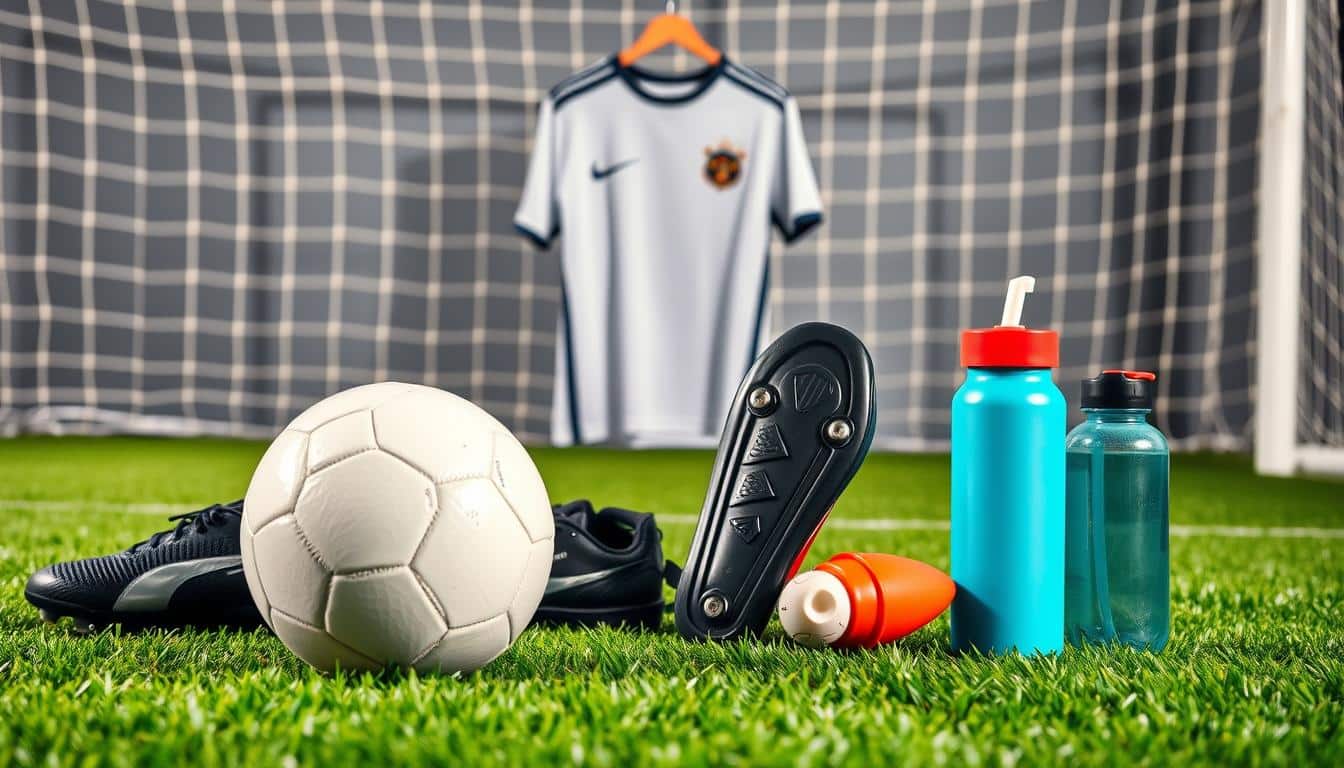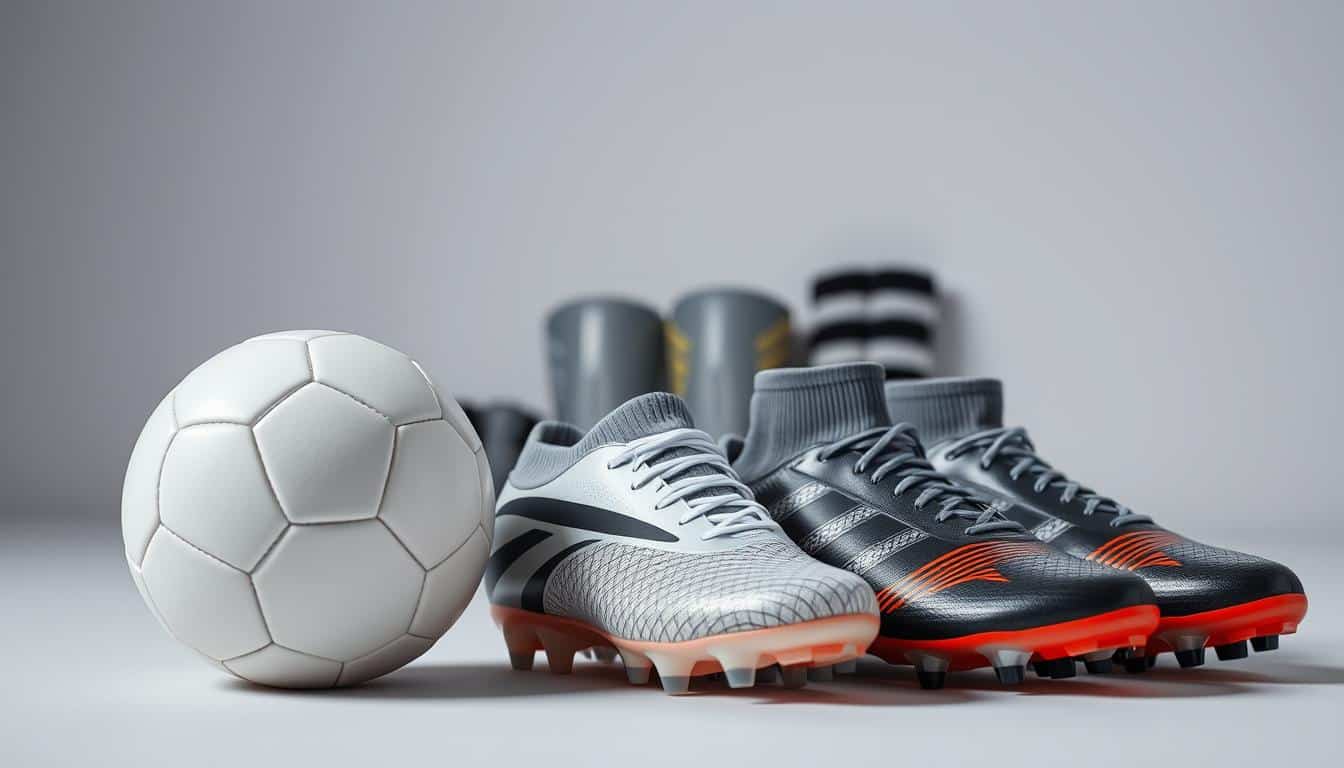Essential Soccer Equipment for Beginners

Starting your journey in the world’s most popular sport doesn’t have to be overwhelming. With the right gear, you’ll stay safe, confident, and ready to learn the basics of the game. Whether you’re joining a youth league or practicing in the backyard, knowing what to prioritize saves time and money—and keeps the focus on fun.
Most leagues require a standard uniform, cleats designed for turf or grass, and protective items like shin guards. Unlike other sports, the checklist is simple, making it an affordable choice for families. Always confirm your local league’s rules before buying anything—some have specific color or style guidelines. For more detailed tips, check out our ultimate parent’s guide to gear shopping.
Key Takeaways
- Proper gear prevents injuries and supports skill development.
- Check league requirements before purchasing uniforms or accessories.
- Balance quality and budget, especially for growing kids.
- Basic items are available at most sporting goods stores or online.
- Regular maintenance keeps gear durable for multiple seasons.
Understanding Your Basic Needs on the Soccer Field
Proper attire is your first step to performing well during practices and matches. The right clothes and shoes keep you focused, comfortable, and ready to adapt to changing conditions. Let’s break down what matters most when prepping for training or game day.
Uniforms and Practice Clothes
Leagues often require specific uniforms, which might include jerseys, shorts, and socks. Some provide these, while others ask parents to order them. Practice outfits should prioritize flexibility and breathability. Moisture-wicking fabrics work best for hot days, pulling sweat away to keep you cool. For colder weather, layer long-sleeve shirts under jerseys to stay warm without restricting movement.
Always pack extra clothes in sealed bags—damp gear after rain can ruin your next session. Keep uniforms separate for games to maintain their quality over time.
Appropriate Footwear and Socks
Cleats designed for grass or turf give you grip and stability. Pair them with specialized socks that stretch over shin guards securely. Regular athletic socks slip down, causing distractions mid-game. After practices, switch to slides or flip-flops to avoid wearing cleats off the field—this extends their lifespan.
| Item | Practice Use | Game Use |
|---|---|---|
| Jersey | Lightweight, breathable | League-approved design |
| Shorts | Flexible material | Matches team colors |
| Socks | Moisture-wicking | Extra length for shin guards |
Must-Have Soccer Equipment for Beginners
New to the game? Prioritize foundational items that keep you safe while building skills. Start with gear that adapts to drills, matches, and unpredictable weather. Let’s explore what belongs in every starter kit.
Balls and Footwear Foundations
Quality matters when choosing your first ball. Avoid lightweight foam versions—they bounce unpredictably and hinder control. Look for size 4 or 5 models with textured surfaces for accurate passing.
Pair your ball with turf-specific footwear. Cleats with molded studs grip grass securely during quick pivots. Break them in during practice to prevent blisters. Always wear moisture-wicking socks—they stay snug over shin guards.
Non-Negotiable Safety Items
Most leagues mandate shin guards—secure them tightly to avoid slippage. Goalkeepers need padded gloves with latex palms for catching power. Don’t forget hydration: insulated bottles maintain water temperature during summer tournaments.
Organize everything in a ventilated bag with separate compartments. This prevents mildew and lets you grab gear quickly during halftime substitutions. Check zippers and straps monthly for wear and tear.
Choosing the Right Soccer Ball and Cleats
Your performance starts with two critical choices: the sphere you kick and the shoes you wear. Matching these to your age and foot shape creates better control and reduces fatigue during games. Let’s simplify your selection process with straightforward guidelines.

Selecting the Correct Ball Size
Balls come in five sizes, but most players only need three. Size 3 (23-24 inches) works best for kids under 8—small enough for easy handling. Pre-teens (8-12 years) use size 4 (25-26 inches) for balanced control. Adults and teens 13+ require size 5 (27-28 inches), the standard for competitive play.
| Ball Size | Age Group | Circumference |
|---|---|---|
| 3 | Under 8 | 23-24 inches |
| 4 | 8-12 years | 25-26 inches |
| 5 | 13+ years | 27-28 inches |
Tips for a Proper Cleat Fit
Your shoes should hug your feet like a second skin. Leave less than half an inch at the toes—excess space causes slips during sharp turns. Test them by jogging in place and bending your knees. If they pinch or slide, try a different style.
Avoid buying larger sizes for growing feet. Poorly fitted cleats lead to blisters and reduced agility. Replace them when your toes touch the front during warm-ups. Break new pairs in gradually with short practice sessions first.
Gear for Enhanced Training and Practice
Elevate your game with smart gear choices that push your limits during solo and group sessions. Focused training tools build precision, speed, and adaptability—qualities that separate casual players from committed athletes. Let’s explore how to upgrade your drills and home setups for maximum progress.
Training Tools for Agility and Drills
Speed ladders sharpen footwork through rapid-step patterns. A 20-foot ladder with 12 rungs lets you practice lateral movements and balance. Pair them with bright cones to design obstacle courses that mimic game-day scenarios.
Resistance bands add power to your workouts. Choose sets offering up to 400 pounds of total resistance for leg drives and core exercises. These tools prevent injuries by strengthening muscles used during sudden stops or kicks.
Additional Accessories for Home Practice
Portable nets transform backyards into shooting ranges. Aim for models with weighted bases to withstand powerful strikes. Attach a ball-retrieval cord to practice dribbling patterns alone—the cord snaps it back for endless reps.
| Equipment | Primary Use | Skill Focus |
|---|---|---|
| Speed Ladder | Footwork Drills | Coordination |
| Cones | Direction Changes | Ball Control |
| Resistance Bands | Strength Building | Injury Prevention |
| Soccer Net | Shooting Accuracy | Power Development |
| Training Ball + Cord | Solo Repetitions | Dribbling Skills |
Always pair physical drills with proper rest and safety guidelines for youth athletes. Rotate equipment weekly to keep workouts fresh and challenging.
Protective Gear for Safety on the Field
Staying safe while playing means focusing on the right protective gear. These items shield vulnerable areas from impacts while letting you move freely. Let’s explore what keeps you secure during tackles, dives, and fast-paced action.
Shin Guards and Ankle Protection
Shin guards are non-negotiable for blocking kicks and accidental collisions. Choose between slip-in styles (hidden under socks) or strap-on versions with Velcro closures. Strap models work best for younger players—they stay put during slides and sprints.
Size matters more than you think. Use height rather than age to pick your fit:
| Guard Size | Player Height | Coverage Area |
|---|---|---|
| Small | Up to 5’2″ | Knee to ankle |
| Medium | Up to 5’10” | Full shin + ankle |
| Large | Up to 6’4″ | Extended protection |
Some guards include built-in ankle padding. This adds defense against twists during sharp turns. Always check that guards don’t restrict movement when sized correctly.
Goalkeeper Gloves and Other Safety Items
Keepers need gloves with latex palms for wet-weather grip. Look for wrist straps to prevent slippage during dives. Replace them when the padding wears thin—usually every 10-15 games.
Other essentials include mouthguards for teeth protection and padded shorts for hard landings. Test all gear during practice first. Ill-fitting items can rub or limit motion, creating new risks instead of preventing them.
Packing the Perfect Soccer Gear Bag
A well-organized bag keeps you prepared for every practice and match. Specialty designs streamline your routine with compartments tailored to hold specific items. This prevents frantic searches during halftime or post-game chaos.
Essentials and Extras Done Right
Look for separate storage zones in your bag. Dedicated pockets for cleats, guards, and uniforms keep dirt from spreading to snacks or electronics. Waterproof sections protect phones during rain delays, while mesh vents prevent mildew in damp clothes.
Indoor shoes need their own space. Store them away from outdoor pairs to avoid transferring turf debris onto courts. Many bags include removable dividers—perfect for isolating muddy gear after wet games.
Prioritize padded shoulder straps and reinforced stitching. These features handle heavy loads during tournaments without tearing. Bonus points for side-access zippers: grab your water bottle quickly without unpacking everything.
| Must-Have Compartments | Recommended Extras |
|---|---|
| Ball sleeve with elastic closure | Insulated pocket for ice packs |
| Vented shoe compartment | Key clip with retractable leash |
| Quick-access outer pocket | Hidden security pouch |
Always stash emergency items in marked sleeves. Bandages, spare laces, and energy bars fit neatly in small pouches. Update your kit monthly—replace used supplies and rotate seasonal gear like gloves or cooling towels.
Wrapping Up Your Gear Preparation
Keeping your gear in top shape ensures you’re always ready to hit the field. Start by wiping down guards after each session and brushing dirt from cleats. Clean gear lasts longer and performs better—no one wants a muddy ball slipping during practice.
Check ball pressure weekly using a gauge. Most need 9-10.5 PSI for optimal bounce and control. Store items indoors to protect materials from cracking in heat or freezing temperatures. A simple closet shelf works better than garages or trunks.
When buying for growing athletes, focus on value over price. Lightweight guards with adjustable straps adapt better than rigid models. Save specialty tools like resistance bands for later—master fundamentals first.
Always verify league rules before upgrading. Some restrict cleat stud types or require specific guard sizes. With care, your starter kit can handle multiple seasons while you focus on skills and fun.
